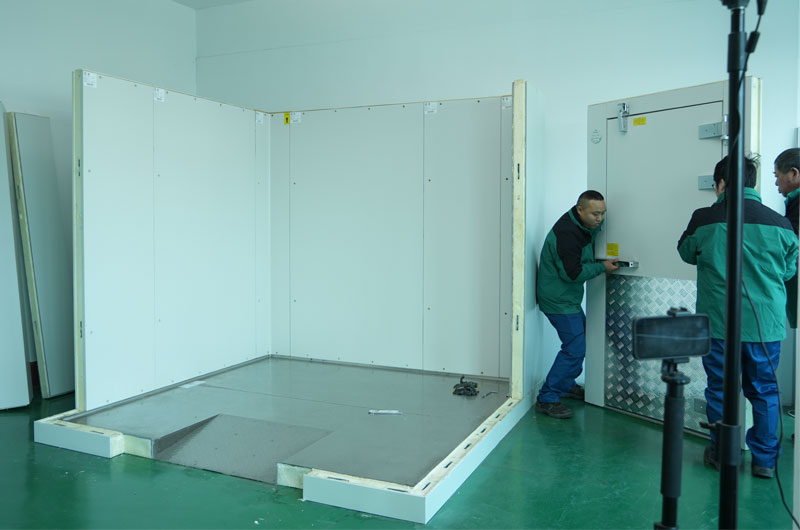Installing a cold room properly ensures efficiency, energy savings, and longevity. Whether you’re retrofitting a space or starting from scratch, this step-by-step guide walks you through the process of installing a cold room.
1. Initial Planning and Site Assessment
Before starting the installation, it’s critical to plan and assess your site. Consider:
- Purpose: Define what the cold room will store — fresh produce, frozen goods, vaccines, etc.
- Temperature range: Determine the ideal operating temperature. Cold rooms typically range from +15°C to -40°C.
- Room size: Based on volume of goods, pallet racking systems, and space constraints.
- Location: Indoors or outdoors; proximity to loading docks, power supply, and drainage systems.
- Regulatory requirements: Check for local building codes, food safety, and fire safety compliance.
A thorough needs analysis will help determine the equipment specifications and layout required for optimal performance.
2. Design and Equipment Selection
Once you have your requirements:
a. Layout Design
Create a detailed floor plan. Include:
- Door placement
- Equipment layout
- Shelving or racking positions
- Airflow considerations
b. Equipment Selection
The major components include:
- Insulated Panels (PUF, PIR, or EPS): For walls, ceilings, and floors
- Refrigeration Unit: Split systems (remote condenser and evaporator) or monoblock systems
- Cold Room Doors: Hinged or sliding; equipped with heater wires for freezers
- Lighting: Moisture-proof LED lights
- Control System: Thermostats and remote monitoring devices
Choose energy-efficient and durable equipment certified for industrial use.
3. Site Preparation
Prepare the site to support cold room assembly:
a. Foundation
Verify that the floor is level and capable of supporting both the cold room structure and the weight of stored products. Install vapor barriers if the cold room is for sub-zero applications to prevent condensation or frost heave.
b. Utilities
Bring in power lines, drainage pipes, and provision for condensate management. Install grounding for electrical safety.
c. Ventilation
Allow for proper airflow around the condensing unit and through ventilation ducts to prevent overheating.
4. Assembling Insulated Panels
Begin constructing the cold room structure using prefabricated insulated panels:
a. Floor Panel Installation
Start with the insulated floor panels if required. Ensure proper alignment, sealing, and load resistance.
b. Wall Panels
- Connect wall panels using cam-lock systems or tongue-and-groove joints.
- Seal joints with silicone or foamed sealants to prevent air leaks.
- Install corner angles for structural integrity.
c. Ceiling Panels
Secure ceiling panels on top of the wall panels. Depending on the size, you may need suspension systems or roof supports to bear the load.
d. Door Installation
Install the door frame into the designated opening. Ensure:
- Proper sealing with gaskets
- Smooth closing and locking mechanisms
- Door heaters (for freezer rooms) are wired correctly
5. Installing the Refrigeration System
The refrigeration system is the heart of the cold room:
a. Positioning
- Mount the evaporator unit inside the cold room, usually on the ceiling or high on the wall for optimal air distribution.
- Place the condensing unit outside or in a ventilated mechanical room.
b. Connecting Components
- Adopt copper refrigerant piping from the condensing unit to the evaporator unit.
- Install insulated drain lines to remove condensate water.
- Use proper brazing techniques and pressure testing for leak-free connections.
c. Electrical Wiring
- Connect the power supply to the condensing and evaporator units.
- Install the thermostat and control systems.
- Wire in alarms or remote monitoring systems if needed.
All wiring should follow local electrical safety codes.
6. Sealing and Insulation Checks
Once the structure and refrigeration system are in place:
- Seal all joints, screw holes, and penetrations with food-safe silicone.
- Inspect gaskets around the door to ensure air-tight sealing.
- Apply foam sealant in corners, edges, and where panels meet.
Proper sealing prevents thermal bridging and reduces energy losses.
7. Testing and Commissioning
Before loading any goods into the cold room:
a. Power-Up
Turn on the refrigeration system and allow the cold room to reach the desired temperature.
b. Temperature Uniformity Test
Use digital thermometers or thermal imaging to check for hot spots or temperature fluctuations inside the room.
c. Leak and Pressure Tests
Ensure there are no refrigerant or air leaks. Inspect drain lines and condensate systems.
d. Electrical Safety Checks
Confirm all electrical connections are safe and grounded. Verify that alarms, sensors, and controls function properly.
Document all results as part of your commissioning report.
8. Shelving and Storage Setup
With the cold room operating correctly:
- Install stainless steel or food-grade plastic shelving.
- Ensure adequate space for airflow between products and walls.
- Label sections for easy inventory management.
Keep frequently accessed items near the door to minimize exposure during entry.
9. Training and Safety Protocols
Train staff on:
- Correct storage practices
- Emergency procedures in case of system failure
- PPE usage (especially for freezer rooms)
- Safe entry and exit procedures
Install signage, emergency lighting, and escape mechanisms on doors.
10. Maintenance and Routine Checks
To ensure long-term reliability:
- Inspect door seals and panel joints regularly.
- Clean evaporator and condenser coils monthly.
- Check refrigerant levels and thermostat calibration.
- Schedule professional servicing every 6–12 months.
Install remote monitoring systems for real-time alerts and data logging.

